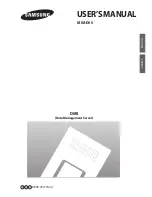
S o n o m a U s e r M a n u a l
74
C H A P T E R N I N E
75
S o n o m a U s e r M a n u a l
C O N T R O L A N D S T A T U S C O M M A N D S
AGC
is the automatic gain control DAC byte, 0 to 255 with larger numbers implying higher
RF gain. Typical range is 150 to 220.
VCDAC is the upper 16 bits of the TCXO voltage control DAC word, 0 to 65535 with larger
numbers implying higher TCXO frequency. Typical range is 20000 to 38000.
This is the oscillator on the CDMA Receiver.
EFCDAC is the system oscillator Electronic Frequency Control 20-bit DAC value, 0 to 1048575
with larger numbers implying higher oscillator frequency. Typical range is 320000 to
680000. This is the system oscillator on the CDMA Subsystem.
SN.R
is the carrier signal-to-noise ratio, 0.00 to 99.9, measured in the CDMA sync channel
symbol rate bandwidth. Typical range is 2.5 to 11.0.
F.ERR
is the CDMA sync channel frame error rate, 0.000 to 1.000, with a higher number
implying more Cyclical Redundancy Check (CRC) failures when processing the sync
channel message frames. Higher numbers will correlate with lower signal-to-noise
ratios.
FLTR
is the fault status for the CDMA Receiver. This is a numeric value consisting of
four hexadecimal characters where each bit indicates a particular receiver fault.
Assertion of any of these bits will light the Alarm LED. Bit definitions are shown below,
Decoding the bits can be difficult for non-programmers. For a more user-friendly method
of reading the fault status use the
faultstat
command. For details on each system
fault see
Appendix G - System Faults
.
Bit 3
Bit 2
Bit 1
Bit 0
Char 0
CDMA Rcvr
FLASH Writes
CDMA Rcvr
FPGA Config
CDMA Signal
CDMA Rcvr
Oscillator DAC
Char 1
CDMA Rcvr
Oscillator
CDMA Reference
Time
Synthesizer
Synthesizer Limits
Char 2
N/A
N/A
N/A
N/A
Char 3
N/A
N/A
N/A
N/A
FLTS
is the fault status for the CDMA Subsystem. This is a numeric value consisting
of four hexadecimal characters where each bit indicates a particular system fault.
Assertion of any of these bits will light the Alarm LED. Bit definitions are shown below.
Decoding the bits can be difficult for non-programmers. For a more user-friendly method
of reading the fault status use the
faultstat
command. For details on each system
fault see
Appendix G - System Faults
.
Содержание Sonoma D12
Страница 2: ......
Страница 20: ...S o n o m a U s e r M a n u a l 4 C H A P T E R O N E This page intentionally left blank...
Страница 32: ...S o n o m a U s e r M a n u a l 16 C H A P T E R T W O This page intentionally left blank...
Страница 48: ...S o n o m a U s e r M a n u a l 32 C H A P T E R T H R E E This page intentionally left blank...
Страница 70: ...S o n o m a U s e r M a n u a l 54 C H A P T E R S I X This page intentionally left blank...
Страница 82: ...S o n o m a U s e r M a n u a l 66 C H A P T E R S E V E N This page intentionally left blank...
Страница 104: ...S o n o m a U s e r M a n u a l 88 C H A P T E R N I N E This page intentionally left blank...
Страница 128: ...S o n o m a U s e r M a n u a l 112 A P P E N D I X A This page intentionally left blank...
Страница 138: ...S o n o m a U s e r M a n u a l 122 A P P E N D I X B This page intentionally left blank...
Страница 154: ...S o n o m a U s e r M a n u a l 138 A P P E N D I X E FIGURE 1B CDMA ANTENNA MOUNTING GUIDELINES WITH PREAMPLIFIER...
Страница 160: ...S o n o m a U s e r M a n u a l 144 A P P E N D I X G This page intentionally left blank...
Страница 166: ...S o n o m a U s e r M a n u a l 150 A P P E N D I X H...
Страница 167: ...151 S o n o m a U s e r M a n u a l S P E C I F I C AT I O N S...
Страница 168: ...S o n o m a U s e r M a n u a l 152 A P P E N D I X H This page intentionally left blank...
Страница 170: ...S o n o m a U s e r M a n u a l 154 S P E C I A L M O D I F I C AT I O N S This page intentionally left blank...
Страница 171: ......
















































